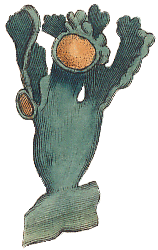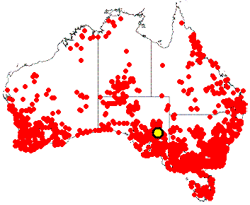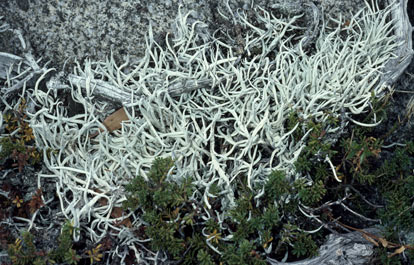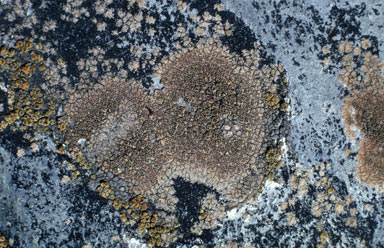 Lichen biogeography
Lichen biogeography
Distribution patterns
Lichen taxa are geographically distributed in a variety of ways and if you look at all those ways it becomes clear that there are certain patterns. For example, there are many taxa found only in Australia, New Zealand and, perhaps, some nearby islands as well. It therefore makes sense to talk of such lichens as having an Australasian distribution. That is an example of a distribution pattern and on this page you'll see descriptions of various other distribution patterns. Much of the information on this page has been taken from the paper listed in the following reference button![]() .
.
Patterns are a useful way of summarising information but they are of course pigeon holes devised by humans. The patterns presented below do cover the distributions of numerous taxa but, not surprisingly, there are taxa that don't fit any of these patterns exactly and you'll see some examples.
This page looks on the world scale and the LICHENS IN AUSTRALIA pages will deal with species (endemic or otherwise) that are found within Australia.
Cosmopolitan
A cosmopolitan taxon is very widespread, typically on all continents and often on many islands as well. While a cosmopolitan taxon is widespread, that is not the same as saying it turns up everywhere since lichens typically have habitat or substrate preferences. For example, Psora decipiens ![]() is found on all continents on calcareous soil (and sometimes on rock) in open habitats. It is a cosmopolitan species but its substrate and habitat preferences clearly rule it out from many parts of the world.
is found on all continents on calcareous soil (and sometimes on rock) in open habitats. It is a cosmopolitan species but its substrate and habitat preferences clearly rule it out from many parts of the world.
Disjunct taxa
The ordinary English word disjunct simply means separated. There are various taxa that are found in widely separated areas of the world, but not in between, and so are referred to as disjunct taxa. Several types of disjunct distributions are known from the Southern Hemisphere. Various taxa are found in two or more of Australasia, South America and Africa, suggesting Gondwanan origins for at least some of them. Such taxa may also be found in one or more of the sub-antarctic islands. In the Northern Hemisphere the amphi-Atlantic taxa are found on opposite sides of the Atlantic, in eastern North America and western Europe. A number of lichen taxa show a western North America - western Europe distribution, being found in the mountains or humid areas of those two regions and there are also American-Asian disjuncts. Each distribution described above shows an east-west disjunction. By contrast the bipolar taxa show a north-south disjunction, being found towards the north of the Northern Hemisphere and the south of the Southern Hemisphere and rarely at latitudes in between.
Neither cosmopolitan nor disjunct but still very widespread
There are many taxa that, though neither cosmopolitan nor disjunct, are nevertheless found over large areas. For example many taxa are found through much of North America and central to northern Eurasia, an area sometimes referred to as the holarctic and the black speckled area on the following map indicates the holarctic.

You'll find a number of taxa around the Pacific rim (and perhaps elsewhere as well) and Hypogymnia pulverata ![]() is a good example since it is known from Australia, New Zealand, China, Japan, the Russian far east and, in North America, Oregon and Quebec. The last is the odd one out, being distant from the Pacific.
is a good example since it is known from Australia, New Zealand, China, Japan, the Russian far east and, in North America, Oregon and Quebec. The last is the odd one out, being distant from the Pacific.
Many lichens are confined to the tropics and amongst these there are three common distribution patterns. The pantropical taxa are widespread throughout the tropics. The paleotropical taxa are found in the Old World tropics (from Africa east to Australasia and the Paciific) but not in the Americas. By contrast taxa that are confined to the American tropics (that is, the New World tropics) are referred to as neotropical. In the previous map the red speckled area shows the paleotropics and the blue speckled area the neotropics.
Of course the neotropical distribution is rather restricted when compared to the distributions already discussed and this brings us to various...
...regional distributions
The page started with one of these by talking about those lichens with an Australasian distribution, such as the species Metus conglomeratus ![]() , which is found in Australia and New Zealand. A little earlier you saw that disjunct simply means separated so it would be quite logical to refer to Metus conglomeratus also as an Australian-New Zealand disjunct, which shows that the different distributional terms are not always mutually exclusive. However, Australia and New Zealand (and some nearby islands) share many things (other than lichen taxa) and there is much sense in using the term Australasian distribution when looking at the world scale.
, which is found in Australia and New Zealand. A little earlier you saw that disjunct simply means separated so it would be quite logical to refer to Metus conglomeratus also as an Australian-New Zealand disjunct, which shows that the different distributional terms are not always mutually exclusive. However, Australia and New Zealand (and some nearby islands) share many things (other than lichen taxa) and there is much sense in using the term Australasian distribution when looking at the world scale.
The species Thysanothecium scutellatum ![]() is found in Australasia and north through parts of Asia to Japan. There are a number of taxa that are found in South-East Asia as well as one or more areas to the north (towards Japan), west (towards India or further) or south and east (towards Australasia or the Pacific). There are climate, vegetation and habitat similarities between various circum-Mediterranean areas so it's not too surprising to learn that certain lichens are found in many areas around the Mediterranean Sea. Along the North Atlantic various taxa are found on the islands between Cape Verde and the Faeroes and at times also in some of the oceanic habitats of western Europe. The Mediterranean and North Atlantic distribution patterns are two examples of regional distributions within the Eurasian continent and you've seen the neotropical distribution as an example of a regional distribution within the Americas. There are various other regional distributions within Eurasia and the Americas. Knowledge of Africa lichens is still very patchy so it is difficult to say much about regional distributions within that continent.
is found in Australasia and north through parts of Asia to Japan. There are a number of taxa that are found in South-East Asia as well as one or more areas to the north (towards Japan), west (towards India or further) or south and east (towards Australasia or the Pacific). There are climate, vegetation and habitat similarities between various circum-Mediterranean areas so it's not too surprising to learn that certain lichens are found in many areas around the Mediterranean Sea. Along the North Atlantic various taxa are found on the islands between Cape Verde and the Faeroes and at times also in some of the oceanic habitats of western Europe. The Mediterranean and North Atlantic distribution patterns are two examples of regional distributions within the Eurasian continent and you've seen the neotropical distribution as an example of a regional distribution within the Americas. There are various other regional distributions within Eurasia and the Americas. Knowledge of Africa lichens is still very patchy so it is difficult to say much about regional distributions within that continent.
Endemic taxa
An endemic taxon is one native to and restricted to a particular area. Hence it's not enough to say a particular taxon is endemic, it's necessary also to say what area it's endemic to. Endemic taxa are of great interest since an endemic taxon may represent a taxon newly evolved in a particular region or a once widespread taxon now reduced to a small area. Endemic, like disjunct, is a term that can be used in alternative descriptions of some distributions. For example, a species native to and confined to Australasia could be described as having an Australasian distribution or as being endemic to Australasia.
The definition of the word endemic obviously poses a slight problem in that it talks of the taxon having a limited distribution whereas the only evidence available to us is where the taxon has been found so far. Having been found in only a limited area need not mean the taxon is restricted to that area. For example, suppose that the description of a new species is published today and the author of the description found specimens in only a limited area. Is the species endemic to that area? Many lichenologists would warn against applying the endemic tag too soon. The species has only recently become known so further field work might soon produce specimens from elsewhere or additional specimens may be found in existing herbarium collections. That's especially the case if the species is visually rather nondescript and best distinguished from other species by subtler microscopic or chemical features. That opens up the possibility of there already being other herbarium specimens of that taxon but perhaps misidentified or still unidentified.
But, how long should you wait? For over a century the species FUSCOPANNARIA SUBIMMIXTA had appeared to be confined to New Zealand and Victoria, hence endemic to Australasia, but in 2002 was reported from South Africa and Chile. Perhaps it had spread from Australasia since the discovery of the species there. No. In the Fuscopannaria case the non-Australasian records were based on re-examination of a couple of old herbarium collections. In fact the South African specimen had been collected several years before the first published description of Fuscopannaria subimmixta.
 Sometimes there is good evidence in favour of regarding a newly discovered species as endemic, even when subtle features distinguish it from other species. Let's look at the example of Xanthoparmelia ewersii
Sometimes there is good evidence in favour of regarding a newly discovered species as endemic, even when subtle features distinguish it from other species. Let's look at the example of Xanthoparmelia ewersii ![]() . At present this species is known only from Australia, in fact just South Australia and only from the Flinders Ranges. The first description of the species was published in 2006 and it is differentiated from others by subtle features. Given what was said in the previous paragraph perhaps Xanthoparmelia ewersii will soon be found elsewhere in Australia - or even outside Australia. That can never be ruled out but the Australian species of Xanthoparmelia have been studied over several decades during the late 20th and early 21st centuries. These studies have included detailed microscopic and chemical examinations and have been based on numerous specimens collected from a large part of Australia. The accompanying map shows places where specimens of Xanthoparmelia have been collected and the yellow dot shows the known distribution of Xanthoparmelia ewersii. The map is likely to under-represent Australian Xanthoparmelia collections since it is based on those collections in Australian herbaria for which information is accessible on-line. The studies into Australian Xanthoparmelias have shown that the country is host to several hundred species of the genus, yet until recently Xanthoparmelia ewersii had not been recorded. Over the past decades the genus Xanthoparmelia has also been well studied from many other parts of the world. All the evidence suggests that Xanthoparmelia ewersii is either confined to South Australia or, if it also grows elsewhere, that is likely to be a rare species in Australia
. At present this species is known only from Australia, in fact just South Australia and only from the Flinders Ranges. The first description of the species was published in 2006 and it is differentiated from others by subtle features. Given what was said in the previous paragraph perhaps Xanthoparmelia ewersii will soon be found elsewhere in Australia - or even outside Australia. That can never be ruled out but the Australian species of Xanthoparmelia have been studied over several decades during the late 20th and early 21st centuries. These studies have included detailed microscopic and chemical examinations and have been based on numerous specimens collected from a large part of Australia. The accompanying map shows places where specimens of Xanthoparmelia have been collected and the yellow dot shows the known distribution of Xanthoparmelia ewersii. The map is likely to under-represent Australian Xanthoparmelia collections since it is based on those collections in Australian herbaria for which information is accessible on-line. The studies into Australian Xanthoparmelias have shown that the country is host to several hundred species of the genus, yet until recently Xanthoparmelia ewersii had not been recorded. Over the past decades the genus Xanthoparmelia has also been well studied from many other parts of the world. All the evidence suggests that Xanthoparmelia ewersii is either confined to South Australia or, if it also grows elsewhere, that is likely to be a rare species in Australia![]() .
.
A big difference between the Fuscopannaria and Xanthoparmelia examples is that at the time when Xanthoparmelia ewersii was described there was already much knowledge about the Australasian and world's Xanthoparmelia species, with that knowledge based on macro and micro morphology, chemistry and ecology. At the time Fuscopannaria subimmixta was first described (originally as Pannaria subimmixta) there was no comparable knowledge of Pannaria and related genera and such knowledge was a long time in coming.
There are many species currently regarded as endemic to various parts of the world and for some the evidence of endemism is stronger than for others. It's clear that, regardless of the evidence used to support endemic status, it is necessary to accept that over time some 'endemic' taxa may be discovered in a distant location and so lose their endemic status.
Oddities
It's possible to devise plausible evolutionary explanations for various common distribution patterns. All the taxa that show an Australasian distribution are likely to have evolved in ancient Australasia. Of course where in Australasia a particular taxon evolved is another question and would demand more detailed investigation. As noted earlier on this page there are various types of disjunct distribution that suggest (but by themselves don't prove) a Gondwanan origin for the taxa concerned. Eurasia and North America are separated but the Bering Strait is a minor obstacle. Moreover at various times of lower sea levels there have been wide land bridges between the two continents. It is therefore easy to see that lichens may have dispersed by that route from one continent to the other. Alternatively what was once a taxon widespread through a united Eurasia-North America may have had its distribution broken into disjunct populations.
However there are some distributions which don't fit common patterns and which are not easily explained. Hypotrachyna consimilis is common in the neotropics but is also found in Papua New Guinea, Taiwan and Sabah. Parmotrema merrillii was originally described from the Philippines but has also been found in Sumatra, Java, Sabah, Papua New Guinea and Bolivia. Of this pair the first is predominantly neotropical, the latter is predominantly paleotropical - but each is found in the opposite tropics. Are both these lichens naturally pantropical species, but each just poorly collected in one of the tropical areas, or is one a neotropical species that has dispersed to the paleotropics while the other, a paleotropical species, has dispersed to the neotropics? Outside AustraliaHeteroplacidium contumescens is known from various areas around or near the Mediterranean and from Central Asia. In Australia it is known from just one site in arid South Australia. Presumably that one site in South Australia is not the only place at which it occurs in Australia, so that further field work could produce collections from elsewhere. For the moment this species remains a biogeographical puzzle. A somewhat similar, but mirror image, puzzle is provided by Ramboldia petraeoides which is known from Australia, New Zealand, South Africa, the Falkland Islands and Sardinia. Apart from Sardinia the species shows a common Southern Hemisphere disjunct (perhaps Gondwanan?) distribution. For the moment the critical unanswered question for each of the Heteroplacidium and Ramboldia species is: Where else in the 'odd' hemisphere is the species found - if at all![]() ?
?
Lichen biogeography pages on this website Distribution patterns |
![An Australian Government Initiative [logo]](/images/austgovt_brown_90px.gif)



